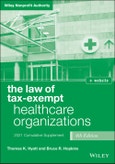Table of Contents
Preface ix
About the Authors xi
Book Citations xv
1 Tax-Exempt Healthcare Organizations: An Overview 1
*§ 1.1 Constitutional Law Perspective 1
§ 1.2 Defining Tax-Exempt Organizations 2
*§ 1.5 Charitable Healthcare Organizations 3
§ 1.8 Promotion of Health 3
*§ 1.10 ABLE Programs (New) 4
3 Criticisms of Tax Exemption 7
§ 3.3 Commerciality Doctrine 7
4 Private Inurement, Private Benefit, and Excess Benefit Transactions 13
§ 4.4 Private Inurement - Scope and Types 13
§ 4.6 Essence of Private Benefit 15
§ 4.9 Excess Benefit Transactions 16
5 Public Charities and Private Foundations 19
§ 5.1 Public Institutions 19
§ 5.6 Recognition of Change in Public Charity Status 20
7 Lobbying and Political Activities 23
§ 7.1 Legislative Activities Limitation 23
§ 7.4 Political Activities Limitation 24
§ 7.5 Business Expense Deduction Rules and Political Activities 27
§ 7.7 Public Policy Advocacy Activities 27
*§ 7.8 Political Activities of Social Welfare Organizations 27
8 Hospitals 29
*§ 8.1 Federal Tax Law Definition of Hospital 29
§ 8.3 Public Hospitals 30
*§ 8.6 Pandemic Relief (New) 31
9 Managed Care Organizations 35
§ 9.3 Commercial-Type Insurance Providers 35
§ 9.5 Recent Developments 35
13 Other Provider and Supplier Organizations 41
§ 13.3 Qualified Nonprofit Health Insurance Issuers 41
§ 13.5 Accountable Care Organizations 42
*§ 13.6 Cannabis-Related Services Organizations (New) 45
16 For-Profit Subsidiaries 49
§ 16.3 Attribution of Subsidiary’s Activities to Exempt Parent 49
17 Exempt and Nonexempt Cooperatives 51
§ 17.1 Cooperative Hospital Service Organizations 51
18 Business Leagues 53
§ 18.1 Business Leagues in General 53
§ 18.2 Healthcare Trade Associations 55
§ 18.3 Certification Organizations and Peer Review Boards 55
19 Other Health-Related Organizations 57
§ 19.4 Hospital Management Services Organizations 57
§ 19.5 Regional Health Information Organizations 58
20 Healthcare Provider Reorganizations 61
§ 20.1 Some Basics about Reorganizations 61
21 Mergers and Conversions 63
§ 21.4 Conversion from Nonexempt to Exempt Status 63
§ 21.5 Joint Operating Agreements 63
22 Partnerships and Joint Ventures 65
§ 22.9 Whole-Hospital Joint Ventures 65
23 Integrated Delivery Systems 67
§ 23.2 Tax Status of IDS Organizations 67
24 Tax Treatment of Unrelated Business Activities 69
§ 24.2 Definition of Trade or Business 69
§ 24.3 Definition of Regularly Carried On 72
§ 24.5 Application of Substantially Related Test to Healthcare Organizations 72
§ 24.5A Deemed Unrelated Business Income 73
§ 24.11 Pharmacy, Medical Supplies, and Service Sales 73
§ 24.12 Laboratory Testing Services 74
§ 24.13 Medical Research 74
§ 24.18 Other Exceptions to Unrelated Income Taxation 76
§ 24.20 Revenue from Controlled Organizations 78
§ 24.20A Partnership Rules 78
§ 24.21 Unrelated Debt-Financed Income 79
§ 24.23 Computation of Unrelated Business Taxable Income 79
25 Physician Recruitment and Retention 89
§ 25.5 Specific Recruitment and Retention Techniques 89
26 Charity Care 91
§ 26.6 Definitional and Reporting Issues 91
§ 26.9 Charity Care and National Health Reform 92
§ 26.10 Additional Statutory Requirements for Hospitals 92
*§ 26.12 Provider Taxes (New) 115
27 Worker Classification and Employment Taxes 117
§ 27.7 Medical Residents and the Student Exception 117
28 Compensation and Employee Benefits 119
§ 28.3 Executive Compensation 119
§ 28.5 Overview of Employee Benefits Law 121
§ 28.6 Deferred Compensation in General 121
*§ 28.7 Excess Executive Compensation (New) 124
30 Tax-Exempt Bond Financing 143
§ 30.3 Disqualification of Tax-Exempt Bonds 143
31 Fundraising Regulation 153
§ 31.2 Federal Law Regulation 153
33 Governance 155
§ 33.3 Good Governance Practices 155
*§ 33.4A IRS Ruling Policy 157
34 Exemption and Public Charity Recognition Processes 163
§ 34.1 Exemption Recognition Process 163
§ 34.5 Public Charity Status 174
§ 34.6 Group Exemption 174
§ 34.7A Notice Requirements for Social Welfare Organizations (New) 180
§ 34.8 Procedure Where Determination Is Adverse 182
§ 34.9 Constitutional Law Aspects of Process (New) 184
35 Maintenance of Tax-Exempt Status and Avoidance of Penalties 187
§ 35.1 Material Changes 187
§ 35.2A Modification of Tax Exemption (New) 189
§ 35.4 Redesigned Annual Information Return 190
§ 35.5 Disclosure Requirements 190
*§ 35.6 IRS Disclosure to State Officials 191
36 IRS Audits of Healthcare Organizations 193
§ 36.2 Audit Procedures 193
Online Resources 207
Cumulative Table of Cases 209
Cumulative Table of IRS Revenue Rulings 221
Cumulative Table of IRS Revenue Procedures 225
Cumulative Table of IRS Private Letter Rulings 227
Cumulative Table of IRS Technical Advice Memoranda 233
Table of Chief Counsel Advice Memoranda 235
Cumulative Table of IRS General Counsel Memoranda 237
Table of Tax Reform Legislation 239
Cumulative Index 245








